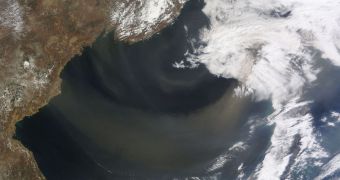Thanks to a series of recent advancements in satellite technology, experts can now quantify the amount of airborne particles that make their way over North America from other areas of the world, every year. The first study of this type indicates that dust makes up most of these particles.
Previously, scientists thought that pollution made up most of these imports, but a research effort conducted by NASA, in cooperation with several universities, proved that to be false. Satellites can now be used to create 3D maps of the particle imports.
Studying such a map demonstrated that most of the tiny airborne particles making their way over the United States and Canada are dust particles from Asia and Africa. Details of the new study were published in the August 2 issue of the top journal Science.
According to the investigation, the continent receives a total of 64 million tons of airborne particles every year, mostly dust and pollution, but also various types of aerosols. Many of these particle types can promote global warming and deteriorate human health.
Interestingly, this amount of particles is only a little smaller than the 69 million tons of aerosols that are produced in the United States yearly, primarily from transportation, industries, natural processes and burning fossil fuels.
“This first-of-a-kind assessment is a crucial step toward better understanding how these tiny but abundant materials move around the planet and impact climate change and air quality,” explains researcher Hongbin Yu.
The expert, who was the lead author of the Science paper, holds an appointment as an atmospheric scientist at the University of Maryland in College Park, and is also based at the NASA Goddard Space Flight Center (GSFC), in Greenbelt, Maryland.
Atmospheric scientists say that quantifying the influence that airborne particles have on the global environment continues to be one of the most difficult and elusive aspects of climate research. These particles do not take into account national borders, and can remain airborne for days, or even weeks.
“Desertification and reclamation – land use modifications that change the exposure of dusty soils to wind erosion – are going to have a big impact on particle distribution and climate around the planet,” explains University of Maryland in Baltimore County atmospheric scientist, Lorraine Remer.
For the new investigation, NASA used data from its Terra and Cloud-Aerosol Lidar and Infrared Pathfinder Satellite Observations (CALIPSO) satellites.

 14 DAY TRIAL //
14 DAY TRIAL //